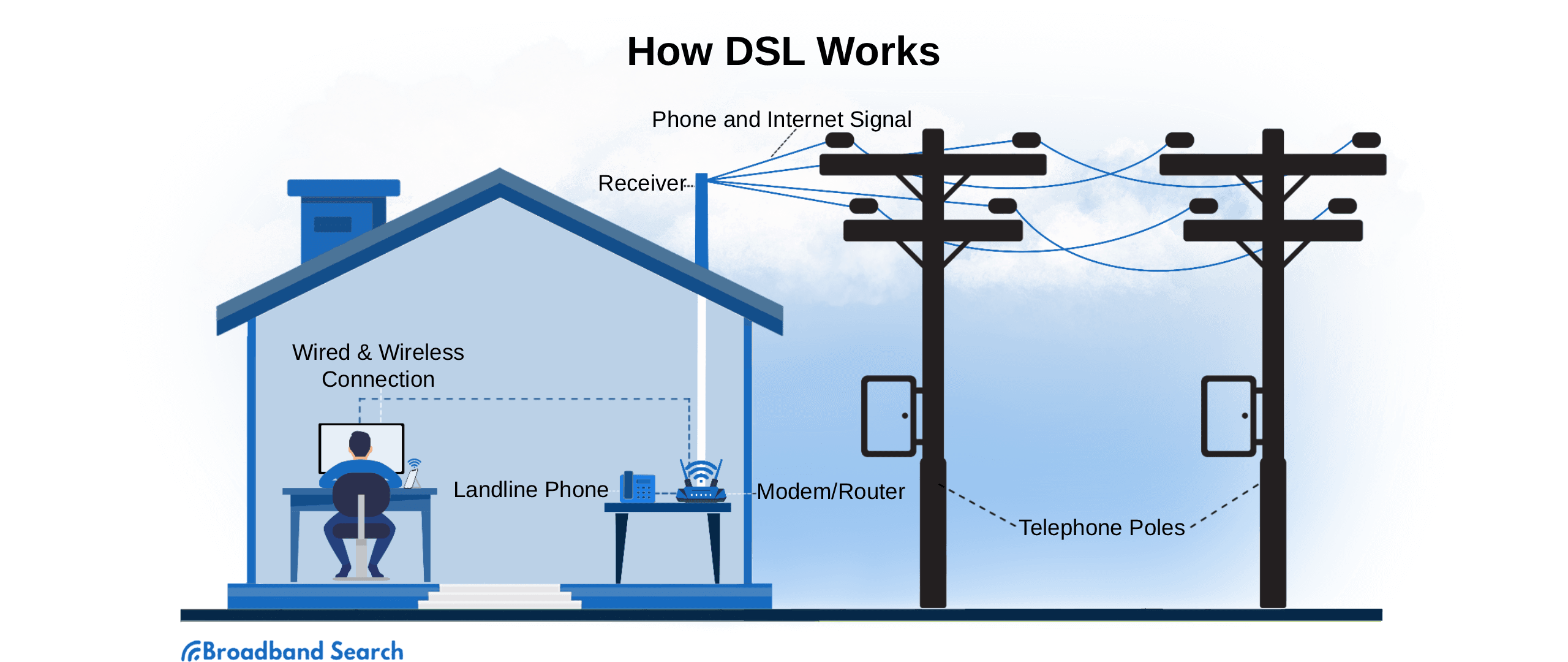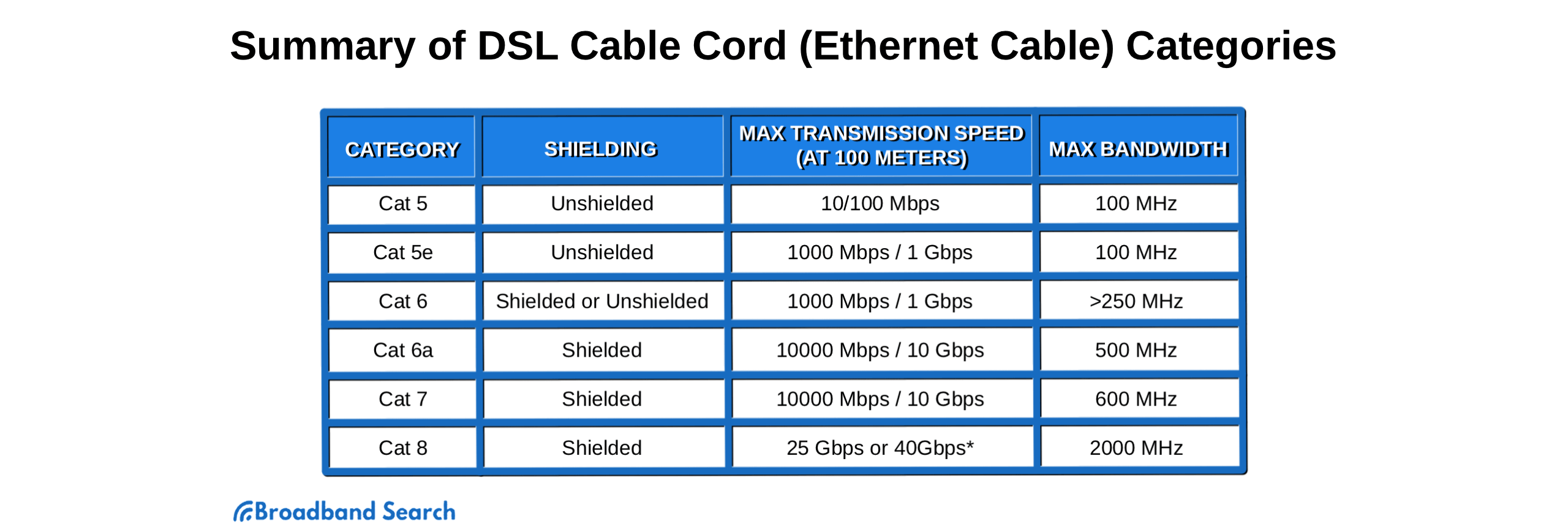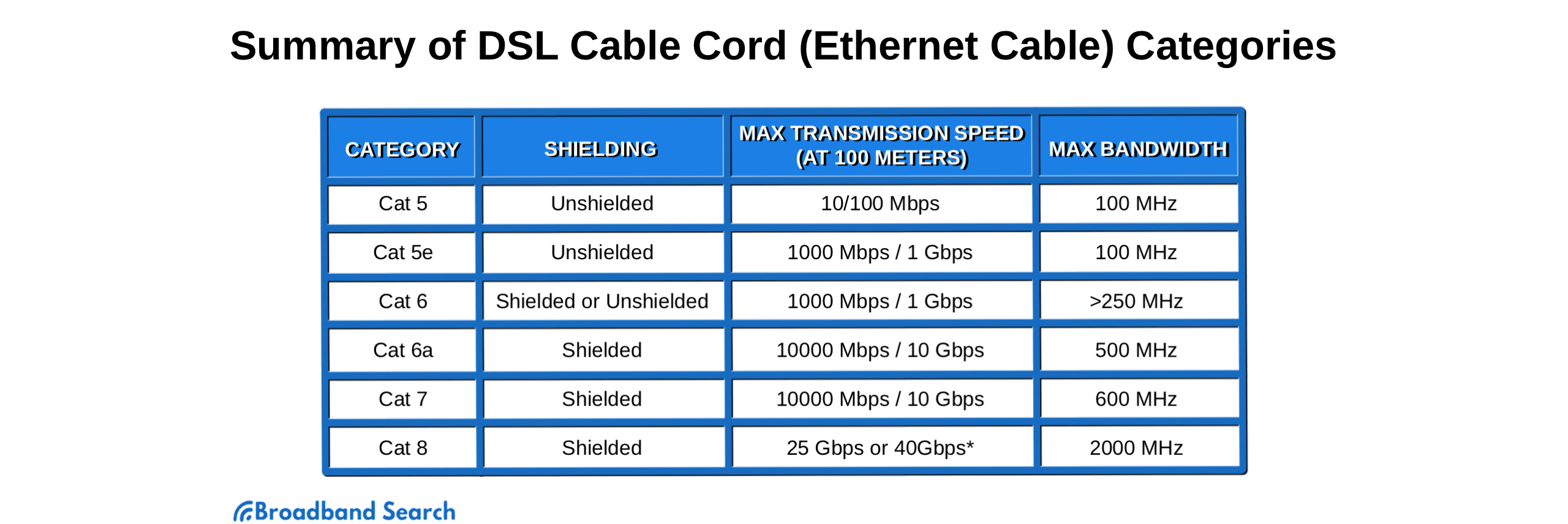DSL is high-speed broadband internet that paved the way for the even faster types of internet connections that we have today. The technology can be traced back to the 1980s and was invented by Joseph Lechleider, considered one of the fathers of DSL internet in the National Inventors Hall of Fame.
DSL is still one of the most common types of broadband used today, and chances are you use it in your home - which is most likely why you’re here trying to learn more about choosing a DSL cable cord.
What is DSL
Before we get into the cables specifically, we think it’s best to give you a little more info about DSL, starting with the definition. DSL stands for Digital Subscriber Line and uses copper telephone wires to provide you with an internet connection. Unlike earlier forms of the internet (such as dial-up), it doesn’t close the line when you use it, which means you can browse the internet and make calls simultaneously.
How DSL Works
If you know anything about DSL, you probably know it’s associated with telephone lines. And if you didn’t know this before, our brief definition of DSL above probably taught you something new. DSL uses these existing telephone lines to send data to and from your home. The thing with telephone lines is that they have a much greater capacity to send data than just using them for telephone calls. This is why DSL can use those same lines for an internet connection. In addition, DSL internet signals use a different operating frequency to those that telephones use, which is why the technology doesn’t interfere with your phone calls.

What Do You Need for DSL Internet to Work
As with every type of internet connection, there will be a few things you’ll need for DSL internet to work. These are as follows:
Telephone Line
As you already know, DSL uses telephone lines to give you an internet connection. Therefore, if you don’t have a telephone line connected to your home, you will not be able to get DSL internet. While landline calls don’t interfere with the internet connection, the quality of the telephone lines in your area can influence the internet speed you get in your home.
DSL Modem
Your DSL modem is what the phone line plugs into and is usually included in your DSL service package. In some cases, DSL modems will be separate from your router, so you will need to connect to it directly with an ethernet cable or connect your router to it. But some modems are also built into the router to make your life easier and reduce the number of devices you’re using to get an internet connection.
Router
The provider usually includes your router in your DSL service package. It allows you to get a Wi-Fi connection in your home, and if your modem is separate, you’ll need to plug the router into the modem to give it wireless capabilities. If your service provider doesn’t include a router in your service package, you can always order one online or find one in an electronics store. Just keep in mind that the type of router you get can affect your connection speed, so it’s a good idea to speak to your ISP to find out which routers they recommend for their customers.
Line Filters
Line filters remove DSL data from the line so you can use the phone without issues. This prevents interference and ensures you have a better connection and experience when using DSL internet or your telephone. Every device that connects to the phone line will need a filter, except for your modem.
Without a line filter, you could experience static sounds when using your telephone, slow internet speeds, and even no internet connection.
DSL Cable Cord
The primary purpose of a DSL cable cord is to connect your modem to the wall and give you an internet connection. The quality of the cable you get will also impact the reliability and speed of your internet connection.
Factors to Consider When Choosing a DSL Cable Cord
Below are some of the requirements that you’ll need to consider when choosing a DSL cable cord:
Performance
There are different types of cables that you can get. These include Cat 5, Cat 5e, Cat 6, Cat 6a, Cat 7, and Cat 8. The main differences between these cables are the shielding, the maximum transmission speeds, and the maximum frequency of each option. When we refer to shielding, we’re talking about shielding around the cables, which is used to protect them externally and prevent the cables from interfering with one another. Let’s take a look at the different cables and their performance features.

You’ll need to consider your internet line’s performance before choosing a cable because you’ll want to choose one that can handle the speed of your line and give you the best experience when using the internet.
Compatibility
The great thing about choosing a cable is that the different types of cables are pretty flexible regarding which ones you can use. They’re backwards compatible, which is what makes them so interchangeable. The main issue with compatibility is that older cables will have a negative impact on the speed that you can get. For example, if you use a Cat 5 cable with a newer modem, data transfer speeds will slow down significantly.
Understanding what you want to do on the internet will help you to choose the right cable and get the best speeds for your needs.
Cable Length
You’ll need a cable that can reach the devices that need to be connected. Cables come in various lengths, including 0.5, 1, 1.5, 2, 5, 10, and 20 meters. Remember to choose a cable slightly longer than the distance to the different connection points. You’ll need some slack if you want the cable to be connected comfortably.
Suppliers
There are a lot of different cable suppliers around, some are specialists, and some are companies that supply various brands. Before choosing a supplier, you’ll first need to consider what the cable is for. If it’s for a company, you may need to go through a specific supplier; if it’s for personal use, you can choose any supplier. Most people look for a good balance between the cost, quality, and availability of different cables.
Best DSL Cable Cord
Since there are different cables around and various suppliers, there are going to be good and bad cables that you can buy. Below are some of the best DSL cable cords available and their features:
Detroit Packing Co. ADSL 2+ High-Speed Broadband Telephone Modem Patch Cable RJ11 to RJ11
Features:
- It can be used with an ADSL modem
- You can buy a cable as long as 100ft
- It has the standard RJ11 connectors
MCL 5m RJ11 6/4 Cable for ADSL Lines
Features:
- It’s a twisted-pair round telephone cable
- It comes with 6P/4C connectors
C2G RJ11 Modem Cable for DSL Internet Connection
Features:
- It has a snagless connector that increases durability and reduces cable strain
- It has the standard RJ11 connectors
- It’s compatible with all DSL modems from the top internet service providers
C2G/Cables to Go 28721 RJ11 High-Speed Internet Modem Cable
Features:
- This cable is double foil shielded to reduce EMI
- There is the option to get a cable as long as 100ft
- It uses the standard RJ11 connectors
Kenable ADSL 2+ High-Speed Broadband Modem Cable RJ11 to RJ11
Features:
- It has RJ11 connectors
- It can reach speeds up to 10 times faster than regular phone cables
Conclusion
Making the decision on which DSL cable to choose isn’t always easy, but with all the information we just shared, hopefully, we’ve made the process a little less confusing. By understanding how DSL works, the different components involved in providing you with an internet connection, and the benefits of the various cables, you’ll be able to make a better decision and get a much better experience when using your DSL internet service. Good luck!
FAQ
How can I optimize DSL internet speed?
There are many ways to optimize the speed you get with DSL internet, from moving devices closer to the router to get the best Wi-Fi connection to changing the DSL cable you’re using.
What are the advantages and disadvantages of DSL internet?
Some of the advantages of DSL internet are: it’s usually more affordable than other types of internet, it’s pretty common to find (since it uses existing phone lines), DSL is relatively fast, and it’s always on (unlike dial-up, which requires you to “request” an internet connection).
Some disadvantages of DSL are: the speed of your connection will depend on your proximity to the distribution point, many options have a data cap, and DSL isn’t as fast or as reliable as some of the newer forms of internet services (such as fiber).
What affects DSL speed?
Your DSL speed can be affected by the quality of the phone lines involved in providing you with an internet connection, your distance from the DSL distribution point, how old the device that you use to connect to the internet is, malware, and much more.
How can I make my DSL signal stronger?
You can make your DSL signal stronger by using the best cables when connecting to the internet. For example, using an ethernet cable to connect your device to your router will give you a more stable connection. In addition, you can use a line filter to minimize interference and improve the strength of the connection.
What is the difference between DSL and fiber?
There are several differences between DSL and fiber. For a start, DSL internet uses existing phone lines to give you an internet connection, while fiber uses glass and plastic fibers. In addition, fiber internet is much more reliable, faster, and has a much higher bandwidth than DSL.

